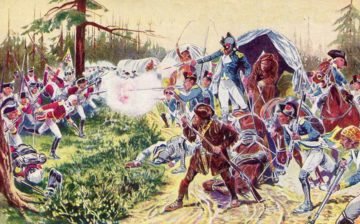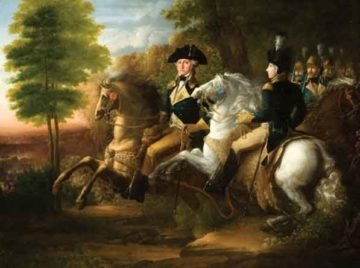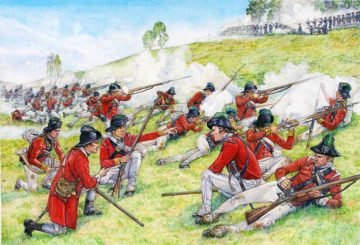The Battle of Brandywine
September 11, 1777 at Brandywine, Pennsylvania

Battle Summary
The Battle of Brandywine was also known as the Battle of Brandywine Creek. The engagement occurred near Chadds Ford, Pennsylvania during General William Howe's Philadelphia campaign to take Philadelphia. More troops fought at Brandywine than any other battle of the Revolutionary War. It was also the longest single-day battle of the war, with continuous fighting for 11 hours.
On July 23, Howe's army departed from Sandy Hook, New Jersey and landed near Elkton, Maryland, in northern Chesapeake Bay. Marching north, the British Army brushed aside American light forces in a few skirmishes. General George Washington offered battle with his army posted behind Brandywine Creek.
While part of his army demonstrated in front of Chadds Ford, Howe took the bulk of his troops on a long march that crossed the Brandywine Creek beyond Washington's right flank. Due to poor scouting, the Americans did not detect Howe's column until it reached a position in rear of their right flank. Belatedly, three divisions were shifted to block the British flanking force at Birmingham Friends Meetinghouse and School, a Quaker meeting house.
After a stiff fight, Howe's wing broke through the newly formed American right wing which was deployed on several hills. At this point Lieutenant General Wilhelm von Knyphausen attacked Chadds Ford and crumpled the American left wing. As Washington's army streamed away in retreat, he brought up elements of Major General Nathanael Greene's division which held off Howe's column long enough for his army to escape to the northeast. Polish Brigadier General Casimir Pulaski defended Washington's rear assisting in his escape.
The defeat and subsequent maneuvers left Philadelphia vulnerable. The British captured the city on September 26, beginning an occupation that would last until June 1778.
Facts about the Battle of Brandywine
- Armies - American Forces was commanded by Gen. George Washington and consisted of about 14,500 Soldiers. British Forces was commanded by Gen. William Howe and consisted of about 15,500 Soldiers.
- Casualties - American casualties were estimated to be 300 killed, 600 wounded, and 400 missing/captured. British casualties were estimated to be 93 killed, 488 wounded, and 6 missing.
- Outcome - The result of the battle was a British victory. The battle was part of the Philadelphia Campaign 1777-78.
Prelude
After Washington's victory at the Battle of Princeton, he had moved his army into quarters near Morristown, New Jersey. He had spent the summer encamped in Watchung Mountains. When he learned of Howe’s movement southward, he marched his army south to Wilmington, Delaware, arriving on August 25. That same day, Howe landed his army at Elk Head.
On July 8, Howe began embarking his 16,500 men on board the British naval transports at Sandy Hook, New Jersey. His intention was to sail via the Delaware Bay to the Delaware River, threatening Philadelphia and preventing Washington from reinforcing Maj. Gen. Horatio Gates's northern army against Lieutenant General John Burgoyne. In the process, Howe might force a battle against Washington.
On July 23, the British fleet set sail and reached the Delaware Bay a week later. Howe received misleading intelligence of American obstructions in the Delaware River that seemed to make an approach from that direction impracticable. He decided to enter the Chesapeake Bay, landing at the northernmost point possible and approach Philadelphia by land.
The Americans were meanwhile kept guessing about Howe's destination. The sighting of the British fleet in the northeast Chesapeake Bay on August 22 and the subsequent British landing at Turkey Point, 8 miles below Head of Elk, Maryland, on August 25 finally put an end to all speculation.
Marching from positions along the Neshaminy Creek in Pennsylvania, the American main army passed through Philadelphia to Darby, reaching Wilmington, Delaware just as the British began their landing. Although Howe's landing was unopposed, his soldiers were seasick and exhausted.
The local Tory inhabitants and deserters from the American dragoons helped to re-equip the British. A concentrated American attack, given the disorganized state of the militia and the distance of the main army, was clearly impossible, and Howe was left to rest and reorganize his army.
On September 3, after a skirmish at Cooch's Bridge, the majority of Howe’s army started marching toward Philadelphia, moving forward in two divisions, one commanded by Knyphausen and the other by Major General Charles Cornwallis. Washington abandoned a defensive encampment along the Red Clay Creek near Newport, Delaware to deploy against the British at Chadds Ford. This site was important as it was the most direct passage across the Brandywine Creek on the road from Baltimore to Philadelphia.
The next 5 days saw the opposing armies positioning themselves along the White Clay Creek, west of Newport and Wilmington. Washington expected Howe to march toward him in Wilmington. Howe preferred to meet the American force elsewhere, thus preventing Washington from making use of the advantageous ground he occupied there. He made a feint north towards Pennsylvania, forcing Washington to change his defensive ground, moving to the Brandywine River at Chadds Ford.
On September 8, Washington ordered Maxwell to take up new positions on White Clay Creek, while the main army encamped behind Red Clay Creek, just west of Newport, Deleware. A small British force marched to demonstrate against the American front while the British main army marched around Washington's right.
On September 9, Washington had seen through Howe's plan and ordered a redeployment of the American main army to Chadd's Ford on the Brandywine Creek. They camped on the east bank. Washington positioned his army on the high ground east of the Brandywine Creek. He positioned brigades and regiments at the main fords, including Buffington’s Ford, Chadd's Ford, and Pyle’s Ford.
Washington was told by an advisor that Howe would try to outflank them by sending his main force northward while a decoy force attacked at Chadds Ford. Washington was aware of this possibility, but had been assured by local informants that Jefferis’ Ford, the next ford above Buffington’s, was difficult to cross, because it was very deep, more than half the height of a man, and that the road southward was poor. Washington expected the British to cross at Chadd's Ford and put most of his army there.
Washington concentrated his defenses at Chadd's Ford, but also prepared to prevent possible British flanking movements to the south or north. Pyle's Ford, south of Chadd's Ford, was covered by two brigades of Pennsylvania militia, commanded Brigadier General John Armstrong. Greene's 1st Division was assigned the primary defense of Chadd's Ford.
Greene's troops straddled the Nottingham Road leading east from the Brandywine Creek. To Greene's right was Brigadier General "Mad" Anthony Wayne's 4th Division. Colonel Thomas Procter's Continental Artillery Regiment was placed to Wayne's right, on the heights at Chadd's Ford.
Chadd's Ford was at the point where the Nottingham Road crossed the Brandywine Creek on the route from Kennett Square to Philadelphia. It was the last natural line of defense before the Schuylkill River. Brandywine Creek, a shallow but fast-flowing creek, was fordable at a comparatively small number of places that could be covered fairly easily.
At Chadd's Ford, made up of two fords about 450 feet apart, the creek was 150 feet wide and commanded by heights on either side. The surrounding area had thick forests and low hills, surrounded by farms, meadows, and orchards.
Battle Begins
September 11 began with a heavy fog, which provided cover for the British troops. Washington received contradictory reports about the British troop movements and continued to believe that the main force was moving to attack at Chadds Ford.
At 5:30 AM, the British and Hessian troops began marching east along the "Great Road" from Kennett Square, advancing on the American troops positioned where the road crossed Brandywine Creek. The first shots of the battle took place about 4 miles west of Chadds Ford, at Welch's Tavern. Element's of Maxwell's Continental light infantry skirmished with the British vanguard.
The British continued to advance and encountered a greater force of continentals behind the stone walls on the Old Kennett Meetinghouse grounds. The battle was fought at mid-morning around the meeting house while the pacifist Quakers continued to hold their midweek service. From the Meetinghouse grounds, the battle continued for three miles to the Brandywine Creek, at Chadds Ford. Eventually, the British pushed the Americans back but not before suffering heavy losses.
At 5:00 AM, the main British column under Cornwallis (and accompanied by Gen. Howe) set out from Kennett Square. Local loyalist sources had provided Howe with knowledge of two unguarded fords, above the forks of the Brandywine. The 17 mile flank march took approximately 9 hours to complete.
Around 2:00 PM, the British appeared on the Americans' right flank and took a much needed rest on Osbourne's Hill, a commanding position North of the Continental army. Having received intelligence from Col. Bland's scouts, Washington ordered Sullivan to take overall command of Stirling and Stephen's divisions (in addition to his own) and quickly march north to meet the British flank attack. As they were forming their lines north of Dilworth, Howe launched his attack.
Having taken overall command of the right-wing of the army, Sullivan left his division to confer with the other generals. His own division he left under the command of Col. Preudhomme de Borre, with orders to shift to the right in order to link up with Stirling and Stephen's divisions.
As the British lines advanced, the Hessian Jaegers threatened to flank the American right, forcing Stephen and Stirling to shift right. Howe was slow to attack, which bought time for the Americans to position some of their men on high ground near Birmingham Meetinghouse, about a mile north of Chadds Ford.
By 4:00 PM, the British attacked. The British Brigade of Guards caught de Borre by surprise on the American left, before de Borre had time to fully form, and immediately sent them in to disarray, causing the entire division to rout. Initially, Stephen's and Stirling's divisions held firm, aided by a battery of artillery on a knoll between their divisions. However, the British light infantry battalions, aided by the Jaegers, eventually caused Stephen's division to fall back.
A bayonet charge by the British grenadier battalions, in the center, similarly forced Stirling to retreat. Lafayette had only just arrived, joining Stirling's division, when he received a wound while trying to rally the retreating troops.
Around 6:00 PM, Washington and Greene arrived with reinforcements to try to hold off the British, who now occupied Meeting House Hill. Washington conferred with Greene and Knox, the latter of whom was head of artillery, in the yard of the William Brinton house.The 2nd Battalion of Grenadiers was nearing their position, and was joined by a fresh reserve brigade (the 4th British Brigade). It was determined that Knox would deploy artillery to slow the British advance. Greene's reinforcements, combined with the remnants of Sullivan's, Stephen's, and Stirling's divisions, formed south of Dilworth and stopped the pursuing British for nearly an hour, letting the rest of the army retreat.
When darkness fell, Greene's division finally began the march to Chester along with the rest of the army. The British army was not able to pursue due to the onset of night. The Americans were also forced to leave behind many of their cannons on Meeting House Hill because almost all of their artillery horses were killed. Location of Stirling's Division on the ridge just west of Birmingham road. The British Grenadier battalions attacked from right to left, ultimately forcing Stirling to fall back with a bayonet charge.
Upon hearing the attack of Cornwallis's column, Knyphausen launched an attack against the weakened American center across Chadd's Ford, breaking through the divisions commanded by Wayne and William Maxwell and forcing them to retreat and leave behind most of their cannon. Armstrong's militia, never engaged in the fighting, also decided to retreat from their positions.
Further north, Greene sent Brigadier General George Weedon's troops to cover the road just outside the town of Dilworth to hold off the British long enough for the rest of the Continental Army to retreat.
Darkness brought the British pursuit to a standstill, which then allowed Weedon's force to retreat. The defeated Americans retreated to Chester where most of them arrived at midnight, with stragglers arriving until morning. The American retreat was well-organized.
Aftermath
Although Howe had defeated the American army, his lack of cavalry prevented its total destruction. Washington had committed a serious error in leaving his right flank wide open and nearly brought about his army's annihilation had it not been for Sullivan, Stirling and Stephen's divisions, which fought for time.
Evening was approaching and, in spite of the early start Cornwallis had made in the flanking maneuver, most of the American army was able to escape. In his report to the Continental Congress detailing the battle, Washington stated: "despite the day's misfortune, I am pleased to announce that most of my men are in good spirits and still have the courage to fight the enemy another day".
On September 12, Washington issued orders for the troops to press on to Germantown. The exhausted British did not pursue the Americans through the night, but remained behind, camping on the battlefield, and treating the wounded and burying the dead.

Battle of Brandywine marker
The Battle of Brandywine was one of the largest land battles, as the only battle in which Washington and Howe fought head-to-head. The victory was a great morale booster for the American army. It is thought to be one of the first battles in which the Ferguson rifle was used and in which the Betsy Ross flag was flown.
British and American forces maneuvered around each other for the next several days with only a few encounters, such as the Battle of Paoli. The Continental Congress abandoned Philadelphia, moving first to Lancaster, Pennsylvania for one day and then to York, Pennsylvania. Military supplies were moved out of the city to Reading, Pennsylvania.
On September 26, British forces marched into Philadelphia unopposed.











